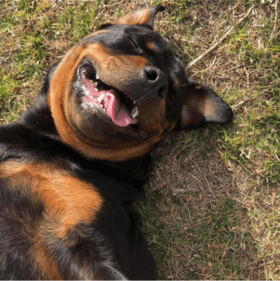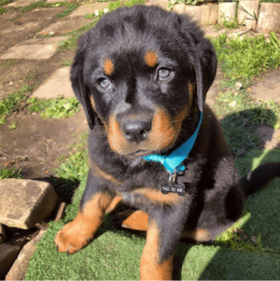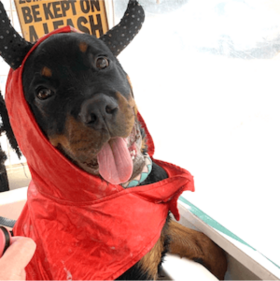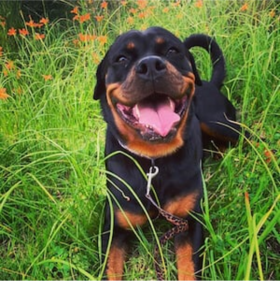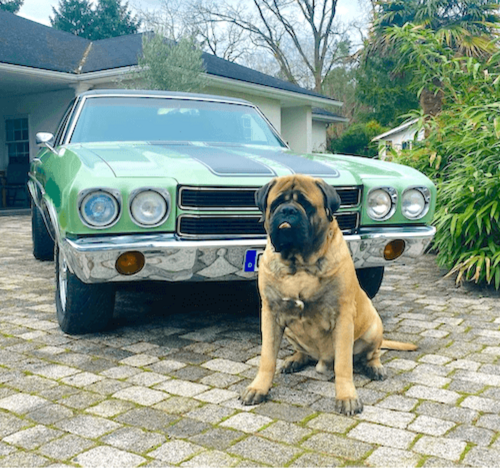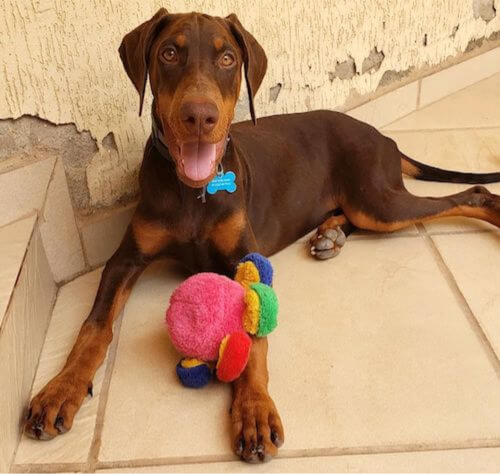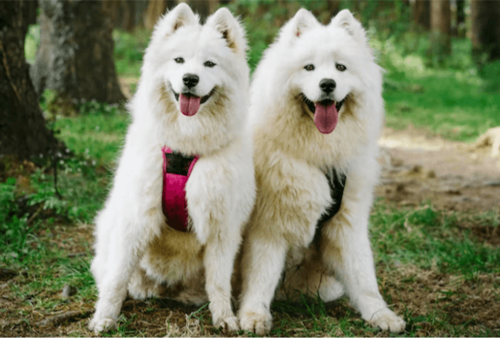Last Updated: 07/05/2025
Rottweiler Breed Guide | Nutrition & Health
Are you thinking of getting a Rottweiler? Take a look at our comprehensive breed guide.
Author: Dr Elise Barry BVSc (Hons)
Reading Time: 40 minutes - long read
The Rottweiler is renowned for its courage and protection. With their stocky, muscular build and surprising agility, they are well known for their guarding abilities. The breed's origins can be traced back to the region of Southern Germany during the 1st century, when mastiff-style droving dogs were discarded by retreating Roman armies. With their large head and trademark black and tan markings, this breed is recognisable the world over. Rottweilers can make wonderfully loyal companions with proper handling and training.
Contents:
Rottweiler Facts
| Â | Â | Â |
|
Breed size: |
Place of origin: |
Other names: |
|
Large |
Germany |
Rottie |
|
Breed group: |
Energy level: |
Weight range: |
|
Working Dogs |
Medium - High |
Female 41-54kg, Male 45-61kg |
|
Life expectancy: |
Tendency to bark: |
Height range: |
|
8-10 years |
Low |
Female: 58-63cm, Male: 63-69cm at shoulder |
|
Drool factor: |
Social needs: |
Coat length: |
|
High (males>females) |
High |
Medium |
|
Shedding factor: |
Overall grooming needs: |
Colours: |
|
Moderate |
Weekly brushing |
Black & tan/mahogany |
How big do Rottweilers get?
Rottweiler males are typically 61-69cm tall at the shoulder and weigh 50-60kg. Females typically measure 56-63cm tall at the shoulder and weigh 35-48kg.
How much does a Rottweiler cost?
Rottweilers can cost anywhere from $200 at an animal shelter to $4000 from a registered breeder. Rottweiler and Rottweiler crosses are frequently available at animal shelters, so it is always worth checking your local rescue centres first - not only will this likely be cheaper than purchasing a dog from a breeder, but you will be saving a life!
Do Rottweilers shed?
Rottweilers shed a lot of hair. They have a double coat and shed heavily twice a year, and moderately during the rest of the year. Regular hair brushing is essential, as is feeding them a top quality diet to keep their fur silky and smooth.
Are Rottweilers good pets?
With the right training and socialisation, Rottweilers can make excellent pets. They have the potential to be loyal, affectionate, and people-oriented dogs. However, because of their history as guard and protection dogs, the work involved in their socialisation shouldn't be underestimated - Rottweilers can be protective, territorial and even aggressive (particularly to outsiders and other animals) by nature, and they require firm, consistent training and copious socialisation from an early age.
How long do Rottweilers live?
The Rottweiler lifespan is 8-10 years. As with any breed, they will live much longer if you feed them a premium quality diet, never let them become overweight, and keep their teeth in top condition!
Do Rottweilers bark a lot?
No, typically Rottweilers do not bark a lot. They are generally a calm breed and not prone to being vocal. They tend to bark when they need to - particularly when they perceive a threat or intruder. To reduce your Rottweiler's barking, ensure you train with positive reinforcement from a young age and reduce problem behaviours before they begin!
How do I choose a Rottweiler breeder?
When looking for a Rottweiler, your options are to: a) adopt from a rescue (this is our top recommendation!) b) buy from an or online marketplace or pet store (NOT recommended!), or c) Research a reputable breeder. Never purchase a puppy without inspecting the breeder's premises and asking the 10 Breeder Checklist Questions first. Good breeders socialise their animals, house them humanely, allow you to inspect their premises, and selectively breed healthy traits and good temperaments. Read our Guide to Finding a Good Breeder for more tips.
Are Rottweilers good with kids?
Despite their size and stature, Rottweilers can be wonderful pets for kids due to their loyalty and protective nature. They are affectionate, playful and big enough not to get injured by kids. However, caution is advised around children unknown to the dog, as Rottweilers can be wary of strangers and may perceive the boisterous, confronting energy of children as a threat.
Rottweiler History
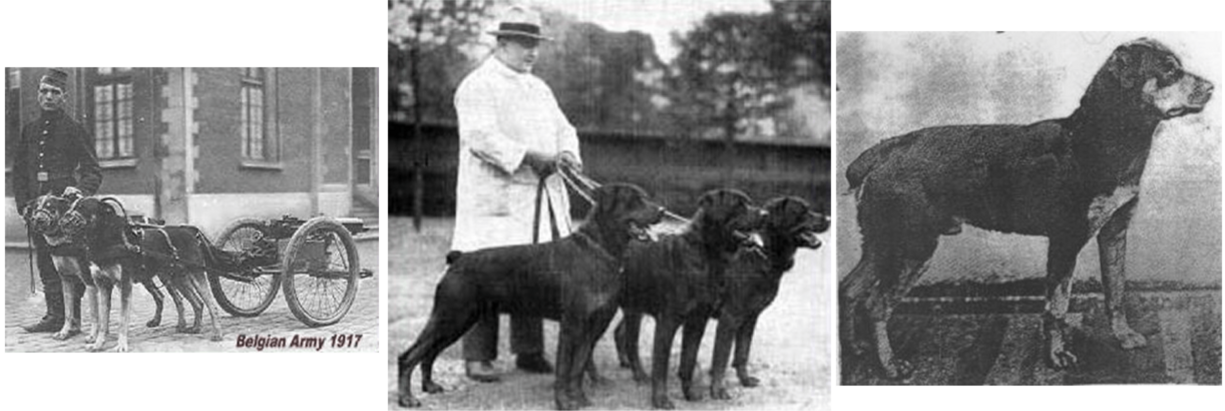
The Roman armies used droving dogs to herd cattle great distances as they extended their empire. In Southern Germany, in the area surrounding the town of Rottweil, these dogs were abandoned following withdrawal of the Romans in the 1st century. During the Middle Ages these mastiff-type dogs were crossed with sheepdogs to produce 'butchers' dogs which were used to herd and guard livestock. The breed had started to diminish following industrialisation however their popularity as service dogs surged in the lead up to World War I. The Rottweiler has been considered an official breed since 1931. They are still renowned for their guarding and protection. They also make loyal companions due to their obedience and trainability.
Rottweiler Personality
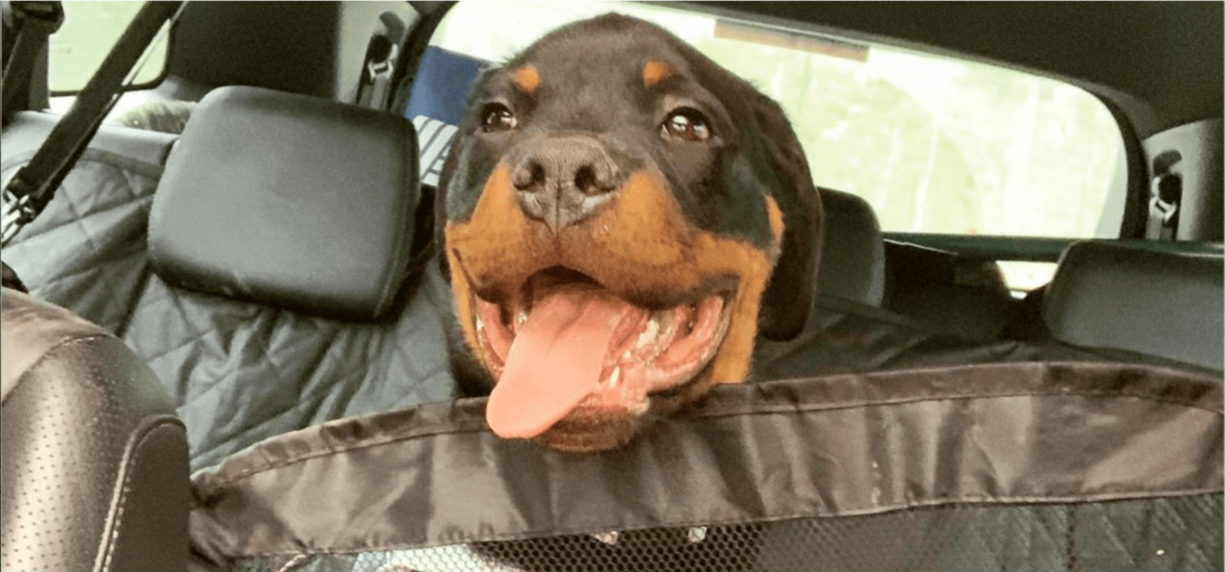
Rottweilers are known for being good-natured and calm despite their intimidating appearance. They are courageous, intelligent and highly alert which all contribute to making them a reliable working dog. They require regular and vigorous exercise. They do not tend to bark unless triggered.
Due to their history as protective and guard dogs, training and socialising are essential. It's recommended to start socialisation and firm training as early as possible to avoid dominance and aggression. Their large, strong, muscular frames mean they're very powerful and energetic. They have a great work ethic, so these dogs need to be well stimulated. A Rottweiler can adapt to any lifestyle, when given plenty of attention, training and exercise.
Top toy recomm-endations for Rottweilers
The best toys for Rottweilers should be robust and tough enough to withstand their large mouths and often rough playing. As they are quite a clever breed, any toy that helps challenge their wits and keeps their mind busy is key!
Made with highly visible, fast drying neoprene, this special Wet Wubba is ideal for games of fetch in and out of water.
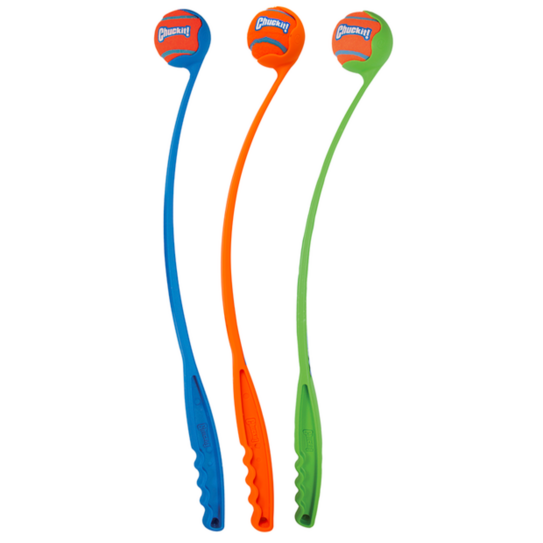
An extra long ball thrower to help you launch your Rottie's ball further than ever before to satisfy those intense fetch cravings!
Luxuriously cuddly, this soft toy is ideal for snuggling and provides comfort to dogs of all ages.
Common Rottweiler Health Problems
Although Rottweilers can be robust, they do have a high probability of acquiring a health problem during their lifespan. Common health issues are eye problems like cataracts, cancer or joint problems.
Cataracts
Cataracts occur when eyes have a cloudy appearance due to changes to the lens. Cataracts can lead to vision loss however they can be removed surgically.
Parvovirus
Parvovirus is a viral infection that can be fatal. Rottweilers are prone to this disease and prevention with vaccination is recommended.
Cancer
Cancer can be commonly seen in Rottweilers. An aggressive tumour derived from bone (osteosarcoma) is the most common cause of early death.
Osteochondrosis dissecans
Osteochondrosis dissecans is a condition involving abnormal development of the cartilage on the end of a bone in the joint. This leads to inflammation, causing pain and lameness. Depending on the severity of the disease, surgery may be necessary.
Hip dysplasia
Hip dysplasia is a condition where the femur and hip joint do not fit together properly, causing pain and lameness. Less severe cases can be treated with anti-inflammatory medication, however surgery may be required for serious cases.
Elbow dysplasia
Elbow dysplasia is common amongst large breed dogs. This heritable condition occurs due to differing rates of bone development in the elbow. It leads to joint mobility, pain and lameness. Less severe cases can be treated with anti-inflammatory medication, however surgery may be required for serious cases.
As with any type of joint disease, arthritis can be a concern. Take a look at our article Arthritis in Dogs to see how to help your Rottie.
Rottweiler Diet and Nutrition
Rottweiler Puppies
Some points to note about Rottweiler puppy ownership include:
⢠Food: Rottweiler puppies should eat a premium, large breed formula such as Royal Canin Rottweiler Puppy, Hills Science Diet Large Breed Puppy or Advance Large Breed Puppy Food until they are 12-18 months of age.
⢠Behaviour: Rottweiler puppies have fantastic goofy personalities but they do like to chew and destroy things, just like any puppy! Puppy proofing your house is essential. Remove any easy-to-reach toxins or electrical cords, and provide plenty of toys!
⢠Worming: Rottweiler puppies need to be wormed fortnightly from the age of 2-12 weeks, and then once per month after this. Rottweiler puppies in Australia also require heartworm protection - you may wish to get a heartworm injection yearly at your vet, or you can simply give a monthly treatment such as Nexgard Spectra, Simparica Trio, or Credelio Plus.
For more helpful information on worming, training, socialisation, and nutrition, consult our veterinary-written Complete New Puppy Guide.
For more information have a look at these recommended articles:
Top food recommendations for Rottweiler Puppies
This premium dry food is specifically formulated to support the health and wellbeing of Rottweiler puppies.
A wholesome, Australian made natural food designed specifically for large breed puppies like the Rottweiler.
This diet is fortified with green lipped mussel powder to promote healthy joints and contains the correct balance of calories, calcium and phosphorus for an optimal, controlled growth rate.
The wellbeing and nourishment of your dog always comes first with Black Hawk. This large breed puppy provides a complete and balanced diets for puppies
Top food recommendations for Adult Rottweilers
Although there are no specific feeding requirements for a Rottweiler, it is very important that you feed your Rottie a suitable premium diet. This food needs to be age appropriate and meet all of their daily nutritional and energy demands. Also, it is very important that you do not overfeed or immediately exercise your Rottie after a meal. Most Large Breed Adult or Puppy Food from premium brands including Hills Science Diet, Royal Canin, or Advance are suitable for Rotties. These scientifically-formulated diets also contain balanced levels of protein, fat and carbohydrate plus vitamins, minerals and antioxidants for health and wellbeing.
As some conditions are prone in Rotties, there are breed specific diets that can help reduce the likelihood of disease. Royal Canin Rottweiler Adult Dry Dog Food has an adapted protein content and l-carnitine to support healthy muscle mass, plus targeted nutrients to promote healthy joints and bones. Plus, this diet has a tailored kibble size specific to the Rottie.
This premium adult dog food is specifically designed for large breed adults and has an adapted calorie content to aid weight control.
With kibble specially designed to slow your Rottie's mouth shape, this premium quality food contains nutrition tailored the the specific requirements of adult Rottweilers.
With feeding such a large dog, many owners need to seek out the best value food they can! Pro Plan is great value without compromising on quality.
This high quality, grain free dry food contains functional ingredients like pumpkin seeds and blueberries to promote immunity, and chicory root for natural sources of prebiotic fibre to support gut health.
Related Breeds
The Rottweiler is part of the Working breed dog group. Over centuries - or even millenia - these dogs were selectively bred to be guards and rescue dogs. The Working breed group consists of some of the most heroic canines in the world, including the Masttif, Boxer, Great Dane, Rottweiler, Husky, Samoyed and St. Bernard. This group consists of the real 'specialists' in their field, each dog excelling in their line of work.
Mastiff
Another large and protective dog, the Mastiff is fairly closely related to the Rottweiler. They are always protective of their family and will step in if danger threatens. Sometimes called the English Mastiff or Old English Mastiff, this dog has an imposing size and can weigh up to 90kg. They have a sleek coat and distinctive black-masked face, and are known for their large amount of slobber.
Dobermann
The Dobermann (or Doberman Pinscher in the United States), is a medium-large breed of dog that was originally developed around 1890 in Germany. The Dobermann has a long muzzle, stands high on its foot pads and is not typically heavy-footed. Dobermans have markings on the chest, paws/legs, muzzle, above the eyes, and underneath the tail. Dobermanns are known to be intelligent, alert, and tenaciously loyal companions and guard dogs.
Samoyed
The Samoyed is a medium-sized Spitz breed which tends to grow to be 16-27kg in weight and 46-56cm in height. They are very fluffy and sport a thick, white double coat and a curled tail, just like many spitz breeds.
Further Reading
Want to know more? Check out our Discover Page for more tips from our expert Vets on keeping your pets happy and healthy.
